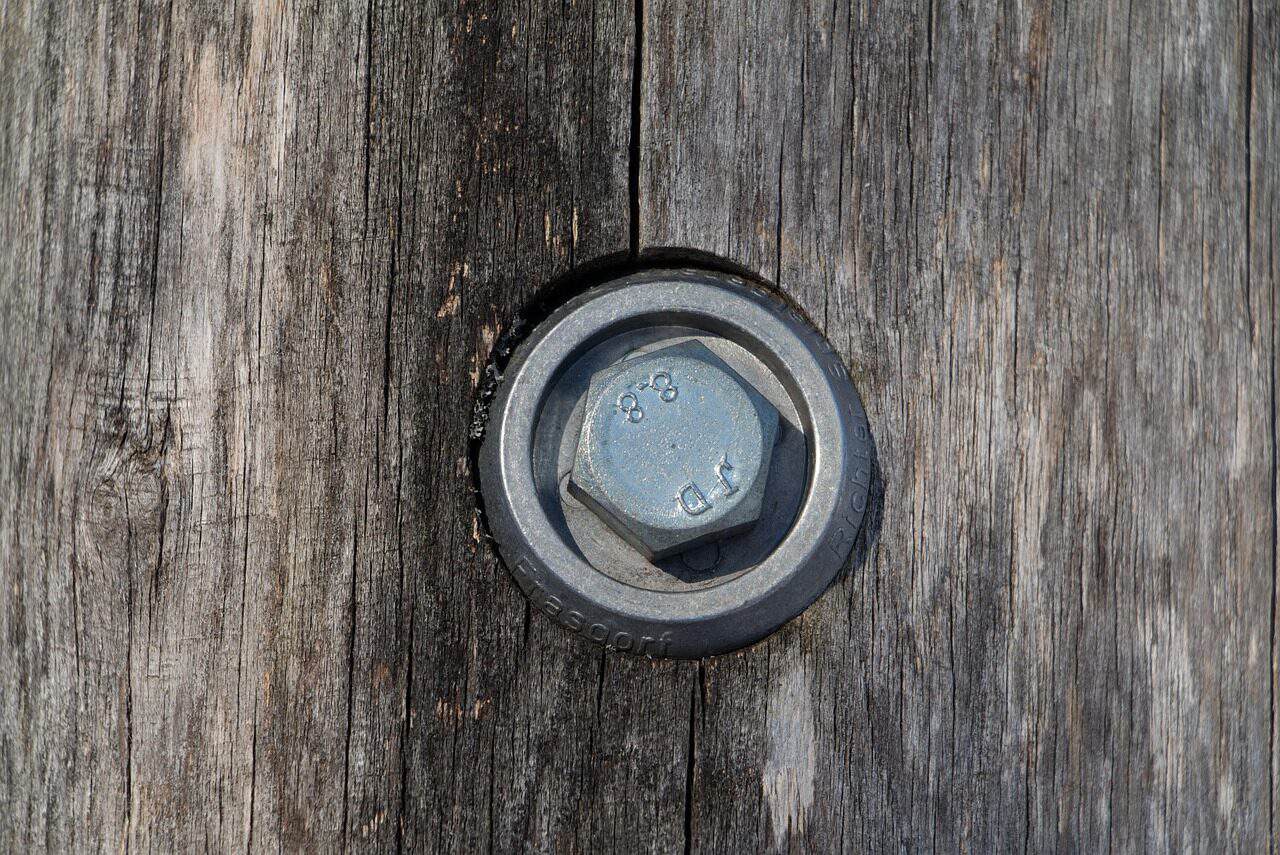A Simple Guide to Keeping Bolts and Nuts Tight: How to Stop Them from Coming Loose
Why Bolts Come Loose
When engineers put parts together with bolts and nuts, they want them to stay tight. But sometimes these connections come apart on their own, which can be dangerous. Think of bolts as strong clamps that hold pieces together with a specific amount of squeezing force. This tight connection faces constant threats from shaking, vibration, and sudden impacts.
The main enemies of tight bolt connections are moving forces, especially vibration and shock. These forces, along with things like parts expanding and shrinking from heat, work constantly to weaken the squeezing force. This starts a process called self-loosening. When a bolt comes loose, it’s not just a small problem – it can cause equipment to break down completely, stop operations, and create serious safety risks.
Regular tightening methods that only focus on turning the bolt to a certain tightness often aren’t enough to keep connections secure in tough conditions. The initial squeezing force created by tightening will get weaker if the right protective steps aren’t taken. This is where special anti-loosening fastening technologies become necessary. These aren’t just different types of nuts and bolts – they are specially designed systems made to fight against the physical forces that cause loosening. This guide gives you a detailed look at this important topic, starting with the basic science of why things come loose and moving to comparing different solutions and how to pick the right one for your needs.
The Science Behind Why Things Come Loose
To effectively stop bolts from coming loose, you first need to understand why it happens. It’s a subtle but powerful process based on how squeezing force, friction, and tiny movements within the connection work together. All anti-loosening fastening methods are built to fight against these basic physical forces.
The Importance of Squeezing Force
When you tighten a bolt, it stretches like a stiff spring. This stretching, or tension, is called preload. Preload is the force that clamps the parts together. This clamping force creates friction at two key places: between the threads of the nut and bolt, and under the surface where the nut or cabeza del tornillo sits. In applications where nothing moves, this friction is usually enough to prevent the nut from turning and backing off. However, when things are moving and shaking, this friction is the first defense to be overcome.

Side-to-Side Forces: The Main Problem
While forces that pull along the bolt’s length can cause the bolt to break from fatigue, it’s side-to-side forces (shear loads that push perpendicular to the bolt) that mainly cause self-loosening. When a connection experiences repeated side-to-side loads, it can cause tiny slipping between the clamped parts. This micro-slip starts the loosening process. Here’s what happens:
- Side Force Applied: A sideways load hits the connection, causing it to bend slightly.
- Tiny Slip Happens: If the side load is strong enough to overcome the friction in the connection, a tiny slip occurs between the thread surfaces and under the nut face.
- Squeezing Force Drops: During this slip, the bolt bends slightly, causing a small drop in squeezing force. This brief reduction in clamping force lowers the friction resistance in the threads.
- Nut Backs Off: The natural loosening force, created by the spiral shape of the thread, can now overcome the reduced friction. The nut makes a tiny turn in the loosening direction.
- Process Repeats: As the load cycles continue, this process repeats thousands or millions of times, with each cycle allowing the nut to back off a little bit more, gradually reducing the squeezing force until the connection fails.
Measuring the Risk
The industry standard for measuring how well a bolt resists this exact type of failure is the Junker Test, defined by DIN 65151. This test uses a special machine that subjects a bolted connection to controlled sideways movement while continuously measuring the remaining squeezing force. The resulting graph of squeezing force versus the number of load cycles gives a clear measure of how effective an anti-loosening fastener is. A fastener that can keep its squeezing force under severe Junker testing is proven to be secure against vibration-caused loosening.
Other Contributing Factors
While side-to-side loading is the main cause, other factors can contribute to or speed up the loss of squeezing force. Temperature changes can cause different amounts of expansion and contraction between the bolt and the clamped materials, especially if they expand at different rates when heated, leading to changes in squeezing force. Also, surface settling can occur as high-pressure contact points on the rough surfaces of the connection parts give way and flatten over time, resulting in a direct loss of bolt stretch and therefore squeezing force.
Types of Loosening Prevention Methods
The wide range of anti-loosening fastening technologies can be overwhelming. To navigate it effectively, it helps to organize the various solutions into categories based on how they work. By understanding how a method intends to prevent loosening, an engineer can better assess whether it’s suitable for a specific use. We can classify almost all anti-loosening methods into one of three main groups.
- Increased Friction: These methods aim to boost the natural friction within the fastener assembly. The goal is to increase the friction forces to a level that is consistently higher than the loosening forces created by vibration and other external loads. This category includes solutions like serrated-flange nuts, spring washers, and nuts that resist turning. Their effectiveness often depends on maintaining enough squeezing force.
- Mechanical Locking: This category goes beyond friction and uses a physical, mechanical barrier or shape to prevent the relative rotation between the nut and the bolt. These methods provide a positive lock that is generally less dependent on squeezing force to work. Examples include castellated nuts with cotter pins, locking wire, and wedge-locking washers.
- Chemical Locking: This approach uses liquid adhesives that don’t need air to harden, known as threadlockers, which are applied to the threads before assembly. The adhesive hardens in the absence of air, filling the tiny gaps between the threads and bonding the parts together. This creates a solid plastic-like material that both locks the threads and seals them against rust, preventing loosening through a combination of sticking and mechanical interference.
This classification provides a structured framework for the detailed analysis that follows, allowing for a logical comparison of the different engineering approaches for achieving a secure connection.

Looking at Mechanical Locking Methods
Mechanical locking methods are often chosen for the most critical applications where connection failure is not acceptable. They provide a high degree of reliability because their function doesn’t depend only on friction, which can be unpredictable and get worse over time.
Castellated Nuts & Pins
A castellated nut, paired with a drilled bolt and a cotter pin (or split pin), is a classic example of positive locking. The nut has slots, or castellations, cut into its top. Once the nut is tightened, a cotter pin is inserted through a hole in the bolt and bent to secure it within one of the nut’s slots. The principle is simple: the pin physically blocks the nut from rotating. Its main advantage is its high reliability and the ease of visual inspection—if the pin is in place, the nut cannot have backed off. However, it has significant drawbacks. Tightening is not precise; the nut must often be slightly loosened or over-tightened to align a slot with the hole, which compromises accurate squeezing force control. The requirement for a custom-drilled bolt also adds cost and complexity.
Locking Wire (Safety Wire)
Common in aerospace and motorsports, locking wire provides a strong solution. The process involves threading a special wire through holes in the heads of multiple fasteners and twisting it in a way that the tension on the wire is always pulling the fastener in the tightening direction. This creates a closed-loop system where each fastener is secured by its neighbor or an anchor point. If one bolt begins to loosen, the wire will tighten and resist the rotation. It is extremely effective against vibration but requires a lot of labor, needs specialized training to install correctly, and adds considerable assembly time.
Wedge-Locking Washers
This technology represents one of the most effective solutions against severe vibration loosening. A typical wedge-locking system, such as the Nord-Lock type, consists of a pair of washers with cams on one side and radial serrations on the other. The key to their function lies in their shape. The angle of the cams (α) is designed to be greater than the pitch of the thread (β). The washer pair is installed with the cam faces together. When the bolt is tightened, the serrations on the outside of the washers grip and lock into the bolt head/nut and the joint surface. If the fastener tries to rotate loose due to vibration, the only possible movement is between the cam faces. Because the cam angle is steeper than the thread pitch, this movement forces the washers to separate, creating an increase in clamping force that actively fights against the loosening rotation and secures the joint. In practical experience with high-vibration machinery, such as rock crushers and rail applications, wedge-locking washers have proven exceptionally effective where friction-based methods fail. However, their performance depends on proper installation; the joint surface must be harder than the washer serrations to ensure proper grip without damaging the component.
Nuts That Resist Turning
These nuts create resistance to rotation independent of squeezing force. They achieve this through a deforming element that creates friction as the nut is threaded onto the bolt. There are two main types. Nylon insert lock nuts (e.g., Nyloc) have a nylon collar at the top that is slightly smaller in diameter than the bolt thread. As the bolt enters, it deforms the nylon, creating a tight frictional grip. They are effective and reusable for a limited number of cycles but are limited by the temperature limit of the nylon, typically around 120°C (250°F). All-metal lock nuts achieve a similar effect by distorting a portion of their own threads (e.g., center-lock or top-lock nuts). These can withstand much higher temperatures, making them suitable for exhaust and engine applications. Their locking action is strong, but they can cause more wear on the bolt threads, and their reusability is limited by metal fatigue in the deformed element.
Comparing Different Methods
Selecting the best anti-loosening fastening method is a critical engineering decision that involves balancing performance, cost, and application-specific needs. There is no single “best” solution; the choice is always a trade-off. A method ideal for a high-temperature engine will be unsuitable for a frequently serviced access panel. This section provides a direct comparison of the most common technologies against key performance criteria to help in this decision-making process.
The following table brings together the characteristics of various methods, offering a clear, side-by-side view. Understanding the criteria is as important as the ratings themselves. Vibration resistance, particularly against side-to-side loads, is the primary measure of security. Reusability is a key factor in applications requiring frequent maintenance and disassembly. Temperature limits determine suitability for environments like engines or furnaces. Finally, dependence on squeezing force determines whether the locking mechanism works even if some initial clamping force is lost.
Table 1: Comparing Anti-Loosening Technologies
| Tecnología | Cómo funciona | Vibration Resistance (Side-to-Side) | Reutilización | Temperature Limit | Depends on Squeezing Force |
| Spring Washer | Friction (Spring Force) | Bajo | Poor (Flattens) | Alta | Alta |
| Serrated Flange Bolt/Nut | Friction (Gouging) | Medio | Poor (Damages Surface) | Alta | Alta |
| Nylon Insert Lock Nut | Friction (Deformation) | Medio-Alto | Limited (Nylon Wears) | ~120°C / 250°F | Bajo |
| All-Metal Lock Nut | Friction (Deformation) | Alta | Limited (Metal Fatigue) | Muy alta | Bajo |
| Wedge-Locking Washer | Mechanical (Shape) | Muy alta | Excelente | Alta | High (Needs squeezing force to work) |
| Castle Nut + Cotter Pin | Mechanical (Obstruction) | Excelente | Excelente | Muy alta | No (Locks position, not squeezing force) |
| Chemical Threadlocker | Chemical (Sticking) | Muy alta | Poor (Requires re-application) | Varies by Grade | Bajo |
For instance, while a spring washer is inexpensive, its low resistance to vibration and poor reusability (it flattens after first use) make it unsuitable for critical connections. In contrast, wedge-locking washers offer top-tier vibration resistance and reusability, but their function depends on having sufficient squeezing force to engage the locking mechanism. A castle nut offers excellent security regardless of squeezing force, but it does not control squeezing force itself and requires custom bolts. By using this table, an engineer can quickly narrow down the viable options based on the non-negotiable requirements of their design.

Choosing the Right Method for Your Application
Translating technical knowledge into real-world success requires matching the right technology to the right application. The operating environment, load characteristics, material properties, and maintenance requirements all determine the most appropriate anti-loosening strategy. A systematic selection process, guided by application-specific challenges, is the hallmark of professional joint design.
The following table provides recommendations for common engineering scenarios, linking the primary challenges of an application to suitable anti-loosening solutions. This serves as a starting point for the design process, highlighting proven solutions for demanding environments.
Table 2: Recommended Anti-Loosening Solutions by Application
| Application / Environment | Desafío(s) principal(es) | Recommended Primary Solution(s) | Notes / Secondary Options |
| Heavy Industrial Machinery | Extreme Vibration, Shock Loads | Wedge-Locking Washers, All-Metal Lock Nuts | Hardened flat washers are essential under wedge-lockers. |
| Aerospace & Automotive Engines | High Vibration, Temperature Changes | Locking Wire, All-Metal Lock Nuts | Traceability and material certification are paramount. |
| Structural Steel Connections | High Static Loads, Surface Settlement | High-Strength Bolting (Tension Control) | Primarily relies on massive squeezing force; loosening is less of a concern. |
| Electronics & Small Assemblies | Small Component Size, Vibration | Nylon Insert Nuts, Chemical Threadlockers (Low Strength) | Avoids high tightening force that could damage components. |
| Maintenance & Repair Access Panels | Frequent Re-use, Vibration | Castellated Nuts, Nylon Insert Nuts | Prioritize solutions with good reusability. |
However, selecting the right component is only half the battle. The integrity of the final connection is equally dependent on proper installation procedure. Even the most advanced anti-loosening fastener will fail if installed incorrectly. Following best practices is not optional; it is a fundamental requirement for achieving design intent. The following checklist outlines critical pre-installation steps.
Table 3: Pre-Installation Best Practices Checklist
| Check Point | Descripción | Why It’s Critical |
| ✓ Clean Threads | Ensure threads on bolt and nut are free of dirt, debris, and excess oil. | Contaminants change the tightening-to-tension relationship, leading to inaccurate squeezing force. |
| ✓ Correct Lubrication | Apply specified lubricant (if any) consistently. | Uncontrolled friction leads to wide squeezing force scatter. Do not lubricate wedge-lockers. |
| ✓ Hardened Surfaces | Verify that joint surfaces are harder than the serrations on fasteners (e.g., wedge-lockers). | Prevents surface damage and ensures the locking mechanism functions as designed. |
| ✓ Proper Tightening Sequence | For multi-bolt joints, follow a star or cross pattern. | Ensures even clamping force and prevents joint distortion. |
| ✓ Calibrated Tools | Use a calibrated torque wrench. | The single most important factor for achieving the target squeezing force. |
By combining application-specific product selection with careful installation practices, engineers can build bolted connections that are not only secure upon assembly but remain secure throughout their intended service life.
The Future of Fastening Technology
The field of fastening technology is not standing still. As machinery becomes more powerful, structures become lighter, and the demand for reliability and real-time data increases, the technology used to hold things together must also evolve. Several emerging and advanced technologies are ready to redefine our approach to joint integrity, moving from passive prevention to active monitoring and control.
- Smart Fasteners: The most significant evolution is putting sensors directly into the fastener itself. These “smart bolts” can include strain gauges, pressure sensors, or other tiny electronics to actively and continuously monitor the squeezing force in the connection. This data can be sent wirelessly to a central monitoring system, providing real-time health updates for critical connections, predicting failures before they happen, and transforming maintenance from a scheduled activity to a condition-based one.
- Sound Wave Measurement: While tightening torque is a convenient substitute, it is an indirect and often inaccurate way to determine squeezing force. Advanced techniques use sound wave devices to measure the precise stretching of a bolt as it is tightened. By sending a sound wave down the length of the bolt and measuring the time it takes to travel before and after tightening, the actual stretch—and therefore the true squeezing force—can be calculated with extreme accuracy. This method is becoming the standard for the most critical applications where squeezing force accuracy is most important.
- Shape-Memory Alloys: Research is underway into fasteners made from or incorporating shape-memory alloys (SMAs). These are materials that can “remember” a previous shape and return to it when heated. A fastener made from an SMA could potentially be designed to increase its clamping force in response to rising temperatures, counteracting the effects of thermal expansion that would normally cause squeezing force to decrease.
These future technologies represent a major shift from a “tighten-and-forget” mentality to one of “tighten-and-monitor,” promising unprecedented levels of safety, efficiency, and control in engineered systems.

Conclusion: Connection Integrity
The self-loosening of fasteners is a fundamental engineering challenge that threatens the safety and reliability of countless mechanical systems. We have seen that this process is driven primarily by the physics of side-to-side vibration overcoming static friction. The solution is not to simply tighten bolts more, but to use a systematic approach to connection design.
This involves a clear understanding of the operating environment, a thorough analysis of how various anti-loosening fastening methods work, and a disciplined application of installation best practices. There is no universal “best” fastener. A wedge-locking washer, a nut that resists turning, or a chemical threadlocker each has its place. The hallmark of a professional engineer is the ability to diagnose the specific demands of an application—vibration, temperature, reusability, squeezing force sensitivity—and select the most appropriate technology to ensure long-term connection integrity. By moving beyond a surface-level understanding and embracing a principles-based approach, we can design and build systems that are strong, reliable, and secure.
- Análisis de uniones atornilladas - MechaniCalc https://mechanicalc.com/reference/bolted-joint-analysis
- Self-Loosening of Bolts – Bolt Science https://www.boltscience.com/pages/vibloose.htm
- Review on Anti-Loosening Methods – ScienceDirect https://www.sciencedirect.com/science/article/pii/S1000936120306063
- Comparative Study on Anti-Loosening Bolts – ScienceDirect https://www.sciencedirect.com/science/article/pii/S1350630722005647
- MIL-HDBK-60 Precarga de tornillos roscados - Biblioteca de ingeniería https://engineeringlibrary.org/reference/threaded-fastener-preload-mil-hdbk
- Fastener Torque Design – NASA Engineering Library https://engineeringlibrary.org/reference/fastener-torque-nasa-design-manual
- Bolted Joint Design Guidelines – Engineering Library (Sandia) https://engineeringlibrary.org/reference/bolted-joint-design-analysis-sandia
- Fastener Design Resources – Engineers Edge https://www.engineersedge.com/fastener_thread_menu.shtml
- Preload Control Methods – Chinese Journal of Mechanical Engineering https://cjme.springeropen.com/articles/10.1186/s10033-024-01082-w
- Vibration-Proof Fasteners Discussion – Eng-Tips https://www.eng-tips.com/threads/vibration-proof-fasteners.57042/




